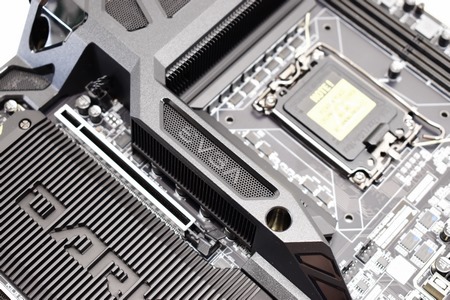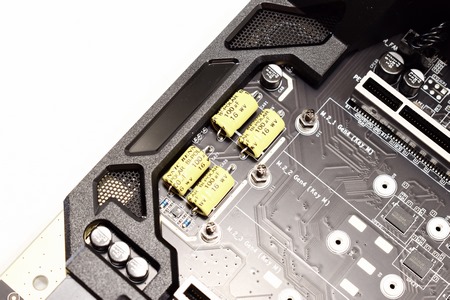THE Z690 DARK KINGPIN
The full size plastic guide is something only EVGA offers (to my knowledge) and it's extremely useful when building, troubleshooting or tweaking your system.
I've used and reviewed most motherboards by EVGA and i have to admit that the Z690 DARK KINGPIN seems the sturdiest of them all.
The aluminum heatsink paired with two high-speed fans (40mm probably) should be enough to keep the 21-phase VRM (18+2+1) in check even for serious overclocking.
Using two DIMM slots allows the Z690 DARK KINGPIN to support DDR5 modules up to well over 6600MHz in speeds (64GB max capacity).
Typically, at the top left corner we find two LED post indicators safeboot (black) button, two CPU PWM fan headers, dedicated USB port for BIOS flashing, and the power on/off and reset buttons.

 Further down we find the PCIe disable switches, slow-mode switch and the BIOS selection switch right next to the angled power ports.
Further down we find the PCIe disable switches, slow-mode switch and the BIOS selection switch right next to the angled power ports.
The G2, U2 and SATA data connectors are all placed right next to each other at the lower right of the motherboard (two 4pin angled pump connectors are also present here).
The internal USB headers and the onboard speaker are all located on the lower end of the motherboard right under 2 rubber covers and next to the extra 6-pin PCIe power connector (according to EVGA this connector provides dedicated power to the PCIe x16 slots, augmenting the +12V power provided by the 24-pin and the GPU directly).
Removing the large heatsink reveals the three Gen4 M.2 sockets.
These four Bennic bi-polar acoustic capacitors are part of the NU Audio headphones amplifier.
Moving at the rear I/O we find a PS/2 connector, two USB 3.2 Gen1 ports, BIOS update and reset CMOS buttons, two Antenna connectors, four USB 3.2 Gen2 ports, two 2.5GbE Ethernet ports, USB 3.2 Gen2x2 Type-C port and the 5.1 analog/digital audio output.
This time EVGA has placed a thick backplate at the base of the Z690 DARK KINGPIN motherboard.
Forgot to remove the plastic rubber covers on the lower end of the motherboard which as you can see also reveal the single PCIe 3.0 x4 slot.
As mentioned earlier for this test I’ll be using the Intel Core i9-12900k paired with Neo Forza’s latest Trinity 32GB 6400MHz CL40 DDR5 kit (review soon) and their 2TB NFP425 SSD.
Finally, since for this test I’ll be using 3 different games to measure performance with E cores enabled and disabled I’ll also be using the HOF GeForce RTX 3080 Ti OC Labs Edition.

 O-Sense
O-Sense

























.png)

